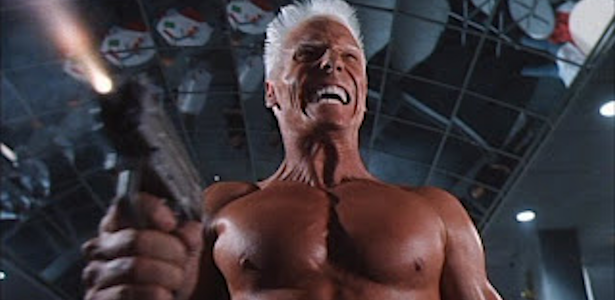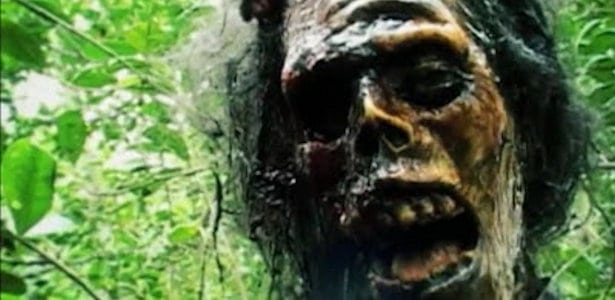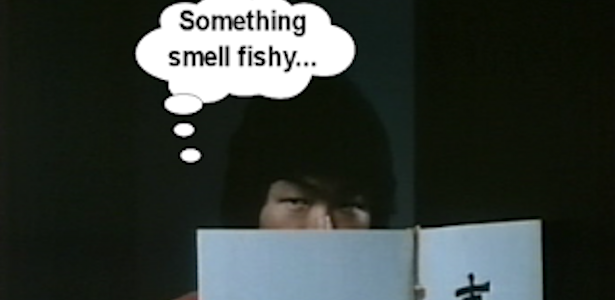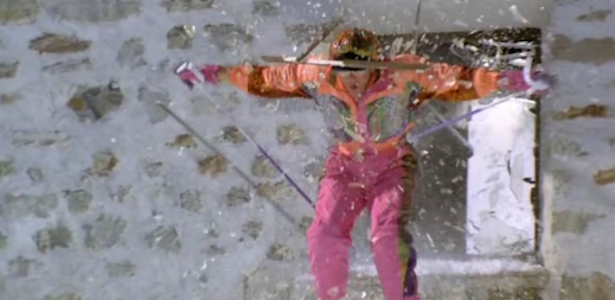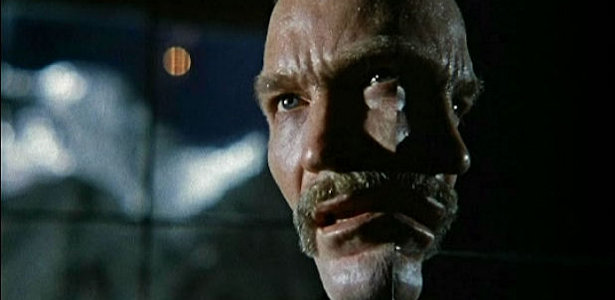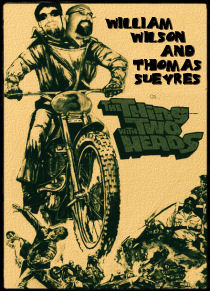Back in the '80s there was a point early on when I discovered that the trashy movies that I had been enjoying were - gasp! - foreign! At the time I felt that the Canadians were trying to pass themselves off as a wannabe America. Clearly they were living in our mighty shadow. I mean, they didn't have to pay to see doctors, they didn't have world-shaking political scandals and nobody gots shot in shopping malls. What kind of country is that, I ask you? Their movies were constantly pretending to be American which I felt was a little duplicitous. Not only are they suffering from an inferiority complex, but they are sneaky too!
Of course, in time I realized that they were making movies that would pander to a specific demographic in order to make wads of cash, and honestly, there is nothing more American than that. I also realized that in many respects their carefree, tax-shelter exploitation movies were not only imaginative and interesting, but in many ways more creative and interesting than many American films during an era that thrived on exploitation.
 In addition, Canadian exploitation films have their own vibe. The way the filmstock looks, the framing of shots, the rather minimalist soundtracks, the generally low-key acting, all gave the films a feel of their own.
While Americans were re-discovering their love of twisty thrillers in the late '80s and early '90s, the sneaky Canucks beat us to the punch with many low-budget crime outings such as Jorge Montesi's BIRDS OF PREY (1985) and this fun techno trip, THRILLKILL, which dares not only to exploit the crime thriller genre, but stuffs in patently gratuitous computer and video game themes.
In addition, Canadian exploitation films have their own vibe. The way the filmstock looks, the framing of shots, the rather minimalist soundtracks, the generally low-key acting, all gave the films a feel of their own.
While Americans were re-discovering their love of twisty thrillers in the late '80s and early '90s, the sneaky Canucks beat us to the punch with many low-budget crime outings such as Jorge Montesi's BIRDS OF PREY (1985) and this fun techno trip, THRILLKILL, which dares not only to exploit the crime thriller genre, but stuffs in patently gratuitous computer and video game themes.
Carly Kendall (Diana Reis) is a chain-smoking video game programmer who has been using her massive black computer terminal to create her latest game "Thrillkill" for a faceless company run by a slimy French businessman Caspar (Frank Moore). Apparently while making the game, she is also hacking into global banks and snatching thousands of dollars from each one and hiding it in a secret account.
Just before her game is to be released, she hides all of the evidence in a password locked file hidden within the game, withdraws all of the money and makes plans to spend the rest of her days south of the equator. Unfortunately for her, Caspar has figured out her plans and with the help of a couple of ruthless henchmen, go after her to get the money.
In the interest of keeping things spoiler free, I'm not going to get into too much detail about the plot, but I will say that paragraph above is genuinely the tip of the iceberg. There are so many twists and double-crosses that the only part of the film that doesn't have a twist is pretty much the last two minutes. It's pretty impressive on any level.
 In addition to the sleazy boss, there is Frank Gillette (Robin Ward, who comes off as a poor man's Leo Rossi) a sleazy detective who is way too interested in the location of the missing money. Apparently he is supposed to be a charming girl-getter. How does he get girls? Oh that's easy, he shows up at the all-female "health place" (a "gym" in modern parlance) where Carly's sister Bobbie is working out and delivers one of the best flirty exchanges since SAMURAI COP (1991):
In addition to the sleazy boss, there is Frank Gillette (Robin Ward, who comes off as a poor man's Leo Rossi) a sleazy detective who is way too interested in the location of the missing money. Apparently he is supposed to be a charming girl-getter. How does he get girls? Oh that's easy, he shows up at the all-female "health place" (a "gym" in modern parlance) where Carly's sister Bobbie is working out and delivers one of the best flirty exchanges since SAMURAI COP (1991):
Bobbie: "Do you get all your dates this way or does tear gas work faster?"
Frank: "Well, tear gas is more effective, but usually they take one look at my nightstick and they come quietly."
Wait, what? If you are going for sleazy innuendo, I'm pretty sure "quietly" is not not the way girls want to be coming. I don't know, maybe I've just dated the wrong kind of girls.
After this exchange she bends to his masculine will and allows him to take her out to a hot dog place for some footlong franks, which he suggestively refers to as "teeny weenies". He says this about five times, just in case it didn't sink in the first four. Seriously dude, if you are going to use slimy come-on lines, you don't want to use the word "teeny". He also eats her dog and drinks her soda. This guy is supa fly!
 The computer game element is another one of those things where it is clear the filmmakers know about computers and video games from what other people told them second hand and just made shit up based on that. Not only does the computer talk to Carly, but after Carly has a cryptic telephone call with her boss, the computer/monolith tells her "we are watching you". A few minutes later when the paranoia starts setting in it says "do you like playing games? You have one minute to find me before I find you". Also, it has the capacity to play live-action video based games in which the player must navigate movie theater corridors using what appears to be a STAR WARS toy blaster to shoot on-screen assailants. Seemingly inspired by the 1974 live action arcade game "Wild Gunman" (not to be confused with the 1984 Nintendo pixel-based reworking of the same name), the filmmakers obviously felt, 10 years later, that the public would pay big bucks and fill an entire room with technology just to have that experience at home.
The computer game element is another one of those things where it is clear the filmmakers know about computers and video games from what other people told them second hand and just made shit up based on that. Not only does the computer talk to Carly, but after Carly has a cryptic telephone call with her boss, the computer/monolith tells her "we are watching you". A few minutes later when the paranoia starts setting in it says "do you like playing games? You have one minute to find me before I find you". Also, it has the capacity to play live-action video based games in which the player must navigate movie theater corridors using what appears to be a STAR WARS toy blaster to shoot on-screen assailants. Seemingly inspired by the 1974 live action arcade game "Wild Gunman" (not to be confused with the 1984 Nintendo pixel-based reworking of the same name), the filmmakers obviously felt, 10 years later, that the public would pay big bucks and fill an entire room with technology just to have that experience at home.
Adding to the general exploitation of the '80s arcade revolution are frequent settings in which games could be seen and heard in the background. During one suspenseful scene in a bar, you can hear the 1982 William's classic "Sinistar" roar "run coward!" on the soundtrack. These scenes also have some almost subliminal edits of video game screens with games such as the 1980 Amstar classic "Phoenix". One great scene has a victim being stalked by a killer in a dark arcade. If that doesn't say '80s, nothing does.
 Probably more importantly, directors Anthony D'Andrea and Anthony Kramreither, deeply saturate the film with '80s imagery; teased hair, gold chains, digital watches, women in leotards, fast food, geometric designs, lots of night photography. Additionally, they go all in on the '80s noir cinematography and even have a shot of a security guard reading Mickey Spillane.
Probably more importantly, directors Anthony D'Andrea and Anthony Kramreither, deeply saturate the film with '80s imagery; teased hair, gold chains, digital watches, women in leotards, fast food, geometric designs, lots of night photography. Additionally, they go all in on the '80s noir cinematography and even have a shot of a security guard reading Mickey Spillane.
Interestingly this is D'Andrea's single writing credit while working as an editor. While the theme of a computer game thriller bears some curious similarities to CLOAK AND DAGGER of the same year, for a first timer, the script is surprisingly well executed. It's a shame that this didn't lead to other work as a writer, I would love to see how his work evolved into future projects, in the same way that Jorge Montesi essentially remade his own SENTIMENTAL REASONS (1981) into the superior BIRDS OF PREY. Kramreither directed a few other films, including the drive-in comedy ALL IN GOOD TASTE (1983), which had an early appearance by a 23rd billed Jim Carrey, but spent his post THRILLKILL career, producing and dabbling in acting.
In the end, I am really only left with only one question:
Of course, in time I realized that they were making movies that would pander to a specific demographic in order to make wads of cash, and honestly, there is nothing more American than that. I also realized that in many respects their carefree, tax-shelter exploitation movies were not only imaginative and interesting, but in many ways more creative and interesting than many American films during an era that thrived on exploitation.
 In addition, Canadian exploitation films have their own vibe. The way the filmstock looks, the framing of shots, the rather minimalist soundtracks, the generally low-key acting, all gave the films a feel of their own.
While Americans were re-discovering their love of twisty thrillers in the late '80s and early '90s, the sneaky Canucks beat us to the punch with many low-budget crime outings such as Jorge Montesi's BIRDS OF PREY (1985) and this fun techno trip, THRILLKILL, which dares not only to exploit the crime thriller genre, but stuffs in patently gratuitous computer and video game themes.
In addition, Canadian exploitation films have their own vibe. The way the filmstock looks, the framing of shots, the rather minimalist soundtracks, the generally low-key acting, all gave the films a feel of their own.
While Americans were re-discovering their love of twisty thrillers in the late '80s and early '90s, the sneaky Canucks beat us to the punch with many low-budget crime outings such as Jorge Montesi's BIRDS OF PREY (1985) and this fun techno trip, THRILLKILL, which dares not only to exploit the crime thriller genre, but stuffs in patently gratuitous computer and video game themes.Carly Kendall (Diana Reis) is a chain-smoking video game programmer who has been using her massive black computer terminal to create her latest game "Thrillkill" for a faceless company run by a slimy French businessman Caspar (Frank Moore). Apparently while making the game, she is also hacking into global banks and snatching thousands of dollars from each one and hiding it in a secret account.
Just before her game is to be released, she hides all of the evidence in a password locked file hidden within the game, withdraws all of the money and makes plans to spend the rest of her days south of the equator. Unfortunately for her, Caspar has figured out her plans and with the help of a couple of ruthless henchmen, go after her to get the money.
In the interest of keeping things spoiler free, I'm not going to get into too much detail about the plot, but I will say that paragraph above is genuinely the tip of the iceberg. There are so many twists and double-crosses that the only part of the film that doesn't have a twist is pretty much the last two minutes. It's pretty impressive on any level.
 In addition to the sleazy boss, there is Frank Gillette (Robin Ward, who comes off as a poor man's Leo Rossi) a sleazy detective who is way too interested in the location of the missing money. Apparently he is supposed to be a charming girl-getter. How does he get girls? Oh that's easy, he shows up at the all-female "health place" (a "gym" in modern parlance) where Carly's sister Bobbie is working out and delivers one of the best flirty exchanges since SAMURAI COP (1991):
In addition to the sleazy boss, there is Frank Gillette (Robin Ward, who comes off as a poor man's Leo Rossi) a sleazy detective who is way too interested in the location of the missing money. Apparently he is supposed to be a charming girl-getter. How does he get girls? Oh that's easy, he shows up at the all-female "health place" (a "gym" in modern parlance) where Carly's sister Bobbie is working out and delivers one of the best flirty exchanges since SAMURAI COP (1991):Bobbie: "Do you get all your dates this way or does tear gas work faster?"
Frank: "Well, tear gas is more effective, but usually they take one look at my nightstick and they come quietly."
Wait, what? If you are going for sleazy innuendo, I'm pretty sure "quietly" is not not the way girls want to be coming. I don't know, maybe I've just dated the wrong kind of girls.
After this exchange she bends to his masculine will and allows him to take her out to a hot dog place for some footlong franks, which he suggestively refers to as "teeny weenies". He says this about five times, just in case it didn't sink in the first four. Seriously dude, if you are going to use slimy come-on lines, you don't want to use the word "teeny". He also eats her dog and drinks her soda. This guy is supa fly!
 The computer game element is another one of those things where it is clear the filmmakers know about computers and video games from what other people told them second hand and just made shit up based on that. Not only does the computer talk to Carly, but after Carly has a cryptic telephone call with her boss, the computer/monolith tells her "we are watching you". A few minutes later when the paranoia starts setting in it says "do you like playing games? You have one minute to find me before I find you". Also, it has the capacity to play live-action video based games in which the player must navigate movie theater corridors using what appears to be a STAR WARS toy blaster to shoot on-screen assailants. Seemingly inspired by the 1974 live action arcade game "Wild Gunman" (not to be confused with the 1984 Nintendo pixel-based reworking of the same name), the filmmakers obviously felt, 10 years later, that the public would pay big bucks and fill an entire room with technology just to have that experience at home.
The computer game element is another one of those things where it is clear the filmmakers know about computers and video games from what other people told them second hand and just made shit up based on that. Not only does the computer talk to Carly, but after Carly has a cryptic telephone call with her boss, the computer/monolith tells her "we are watching you". A few minutes later when the paranoia starts setting in it says "do you like playing games? You have one minute to find me before I find you". Also, it has the capacity to play live-action video based games in which the player must navigate movie theater corridors using what appears to be a STAR WARS toy blaster to shoot on-screen assailants. Seemingly inspired by the 1974 live action arcade game "Wild Gunman" (not to be confused with the 1984 Nintendo pixel-based reworking of the same name), the filmmakers obviously felt, 10 years later, that the public would pay big bucks and fill an entire room with technology just to have that experience at home.Adding to the general exploitation of the '80s arcade revolution are frequent settings in which games could be seen and heard in the background. During one suspenseful scene in a bar, you can hear the 1982 William's classic "Sinistar" roar "run coward!" on the soundtrack. These scenes also have some almost subliminal edits of video game screens with games such as the 1980 Amstar classic "Phoenix". One great scene has a victim being stalked by a killer in a dark arcade. If that doesn't say '80s, nothing does.
 Probably more importantly, directors Anthony D'Andrea and Anthony Kramreither, deeply saturate the film with '80s imagery; teased hair, gold chains, digital watches, women in leotards, fast food, geometric designs, lots of night photography. Additionally, they go all in on the '80s noir cinematography and even have a shot of a security guard reading Mickey Spillane.
Probably more importantly, directors Anthony D'Andrea and Anthony Kramreither, deeply saturate the film with '80s imagery; teased hair, gold chains, digital watches, women in leotards, fast food, geometric designs, lots of night photography. Additionally, they go all in on the '80s noir cinematography and even have a shot of a security guard reading Mickey Spillane.Interestingly this is D'Andrea's single writing credit while working as an editor. While the theme of a computer game thriller bears some curious similarities to CLOAK AND DAGGER of the same year, for a first timer, the script is surprisingly well executed. It's a shame that this didn't lead to other work as a writer, I would love to see how his work evolved into future projects, in the same way that Jorge Montesi essentially remade his own SENTIMENTAL REASONS (1981) into the superior BIRDS OF PREY. Kramreither directed a few other films, including the drive-in comedy ALL IN GOOD TASTE (1983), which had an early appearance by a 23rd billed Jim Carrey, but spent his post THRILLKILL career, producing and dabbling in acting.
In the end, I am really only left with only one question:




